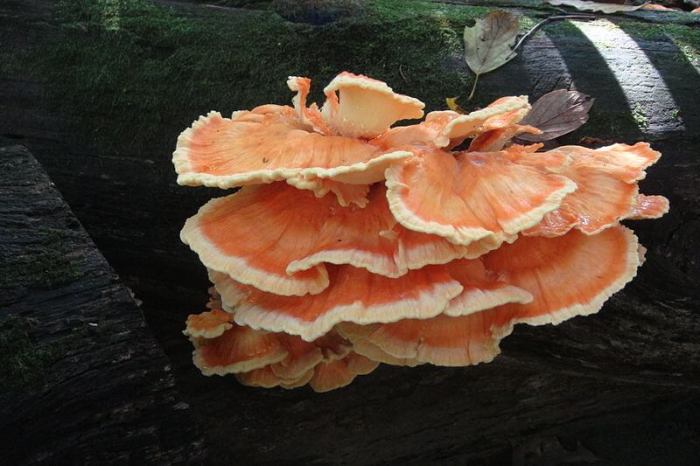
Embark on a culinary journey with our comprehensive guide to the delectable chicken of the woods recipe. From foraging tips to cooking techniques, this recipe will tantalize your taste buds and ignite your culinary passion.
Whether you’re a seasoned chef or a curious home cook, this guide will empower you to create mouthwatering dishes that showcase the unique flavors of chicken of the woods.
Recipe Preparation

Preparing chicken of the woods for cooking involves several key steps. Firstly, it’s crucial to thoroughly clean the mushroom to remove any dirt or debris. This can be done by gently brushing off any loose particles with a soft brush or rinsing it briefly under running water.
Avoid soaking the mushroom as it may absorb excessive moisture.
Once cleaned, the chicken of the woods should be cut into bite-sized pieces. This helps ensure even cooking and makes it easier to incorporate into various dishes. Use a sharp knife to slice the mushroom into thin strips or cubes, depending on your preference.
Techniques
To prepare chicken of the woods, several techniques can be employed. One common method is sautéing, where the mushroom is cooked in a pan with a small amount of oil or butter. This technique allows for caramelization and brings out the mushroom’s savory flavors.
Alternatively, chicken of the woods can be roasted in the oven for a crispy texture. Roasting helps develop a rich, nutty flavor and is a great option for incorporating the mushroom into soups, stews, or salads.
Another popular technique is grilling. Grilling chicken of the woods imparts a smoky flavor and a slightly charred exterior. This method is ideal for creating a flavorful accompaniment to grilled meats or vegetables. Additionally, chicken of the woods can be used to make a delicious vegan “pulled chicken” by shredding the cooked mushroom and combining it with a flavorful sauce.
Cooking Methods

Chicken of the woods can be cooked using various methods, each offering unique advantages and disadvantages. Whether you prefer the smoky flavor of grilling, the versatility of sautéing, or the juicy tenderness of roasting, there’s a cooking method to suit your taste.
Grilling
Grilling chicken of the woods is a popular method that imparts a delicious smoky flavor. The high heat of the grill quickly sears the mushroom, creating a crispy exterior while keeping the interior tender and juicy. To grill chicken of the woods, preheat your grill to medium-high heat (about 400-450°F).
Brush the mushroom with olive oil and season with salt and pepper. Grill for 5-7 minutes per side, or until tender and slightly charred.
Sautéing
Sautéing chicken of the woods is a versatile cooking method that allows you to control the heat and cook the mushroom to your desired doneness. Heat a large skillet over medium heat and add a drizzle of olive oil. Add the chicken of the woods and cook for 5-7 minutes, stirring occasionally, until tender and browned.
You can add additional ingredients to the skillet, such as garlic, onions, or herbs, to enhance the flavor.
Roasting
Roasting chicken of the woods is a great way to bring out its natural sweetness and umami flavor. Preheat your oven to 400°F. Toss the chicken of the woods with olive oil, salt, and pepper. Spread the mushroom on a baking sheet and roast for 15-20 minutes, or until tender and slightly browned.
Flavoring and Seasoning
Chicken of the woods is a versatile mushroom that can be flavored with a variety of herbs, spices, and sauces. Its meaty texture and mild flavor make it a great candidate for marinating or rubbing, allowing the flavors to penetrate deep into the mushroom.
Popular herbs and spices that complement chicken of the woods include thyme, rosemary, oregano, garlic, and paprika. These herbs and spices can be used individually or in combination to create a flavorful blend. Sauces such as soy sauce, teriyaki sauce, and barbecue sauce can also be used to add flavor and moisture to the mushroom.
Marinades
Marinating chicken of the woods in a flavorful liquid helps to tenderize the mushroom and infuse it with flavor. A simple marinade can be made with olive oil, lemon juice, garlic, and herbs. The mushroom should be marinated for at least 30 minutes, but can be marinated for up to 24 hours.
Rubs
Rubs are a great way to add flavor to chicken of the woods without adding any additional moisture. A simple rub can be made with salt, pepper, and garlic powder. The rub should be applied to the mushroom before cooking.
Serving Suggestions: Chicken Of The Woods Recipe
Chicken of the woods is a versatile mushroom that can be enjoyed in a variety of ways. Whether you’re serving it as a main course, appetizer, or side dish, there are endless possibilities.
As a main course, chicken of the woods can be grilled, roasted, or fried. It can be served with a variety of sides, such as rice, pasta, or vegetables. It can also be used in soups, stews, and casseroles.
As an Appetizer
As an appetizer, chicken of the woods can be served fried or baked. It can be served with a dipping sauce, such as ranch dressing or marinara sauce.
As a Side Dish
As a side dish, chicken of the woods can be grilled or roasted. It can be served with a variety of main courses, such as steak, chicken, or fish.
For another take on this classic dish, check out this chicken of the woods recipe . This recipe uses a different blend of spices and herbs to create a unique flavor that’s sure to please even the most discerning palate.
Accompaniments
Chicken of the woods pairs well with a variety of accompaniments, such as salads, vegetables, and sauces. Some popular salads to serve with chicken of the woods include green salad, Caesar salad, and potato salad. Some popular vegetables to serve with chicken of the woods include roasted vegetables, steamed vegetables, and grilled vegetables.
Some popular sauces to serve with chicken of the woods include mushroom sauce, gravy, and barbecue sauce.
Creative Presentations and Garnishes, Chicken of the woods recipe
Chicken of the woods can be presented in a variety of creative ways. One popular way to present chicken of the woods is to arrange it on a platter with other mushrooms, such as oyster mushrooms or shiitake mushrooms. Another popular way to present chicken of the woods is to stuff it with a variety of fillings, such as bread crumbs, cheese, or vegetables.
If you’re looking for a unique and delicious mushroom dish, try out this chicken of the woods recipe . This recipe is easy to follow and will give you a flavorful dish that’s sure to impress your friends and family.
Some popular garnishes for chicken of the woods include parsley, chives, and thyme.
Nutritional Benefits

Chicken of the woods is a highly nutritious mushroom that offers a range of health benefits. It is a good source of protein, fiber, and vitamins.
Chicken of the woods is a low-calorie food, providing only about 30 calories per 100 grams. It is also low in fat and carbohydrates, making it a good choice for people who are trying to lose weight or maintain a healthy weight.
The distinctive orange-hued chicken of the woods mushroom offers a delectable and meaty alternative to chicken. Whether you’re an avid mushroom hunter or simply curious about this culinary gem, a chicken of the woods recipe is a must-try. This fungus boasts a firm texture that holds its shape well during cooking, making it perfect for sautéing, grilling, or even frying.
Protein
Chicken of the woods is a good source of protein, providing about 10 grams of protein per 100 grams. This makes it a good choice for vegetarians and vegans who are looking for a plant-based source of protein.
Fiber
Chicken of the woods is also a good source of fiber, providing about 5 grams of fiber per 100 grams. Fiber is important for maintaining a healthy digestive system and can help to lower cholesterol levels and reduce the risk of heart disease.
Vitamins
Chicken of the woods is a good source of several vitamins, including vitamin C, vitamin D, and niacin. Vitamin C is important for immune function and skin health, vitamin D is important for bone health, and niacin is important for energy production.
Potential Health Benefits
In addition to its nutritional value, chicken of the woods has also been shown to have several potential health benefits. These benefits include:
- Antioxidant activity
- Anti-inflammatory activity
- Anti-cancer activity
- Immune-boosting activity
Chicken of the woods is a versatile mushroom that can be cooked in a variety of ways. It can be sautéed, roasted, grilled, or fried. It can also be used in soups, stews, and casseroles.
Comparison to Other Mushrooms and Poultry
Chicken of the woods compares favorably to other types of mushrooms and poultry in terms of its nutritional value. It is a good source of protein, fiber, and vitamins, and it has several potential health benefits. However, it is important to note that chicken of the woods is not a good substitute for poultry in terms of its taste or texture.
Last Word

As you savor the last bite of your chicken of the woods creation, let the memories of its rich flavors linger. This versatile ingredient has not only satisfied your hunger but has also taken you on a culinary adventure that will stay with you long after the meal is finished.
So, gather your ingredients, fire up your stove, and let’s dive into the enchanting world of chicken of the woods!
FAQ Explained
Can I substitute chicken of the woods with other mushrooms?
Yes, oyster mushrooms or shiitake mushrooms can be used as substitutes, although they may have slightly different flavors and textures.
How long can I store cooked chicken of the woods?
Cooked chicken of the woods can be stored in an airtight container in the refrigerator for up to 3 days.
What are the nutritional benefits of chicken of the woods?
Chicken of the woods is a good source of protein, fiber, vitamins, and minerals, including vitamin D, potassium, and niacin.